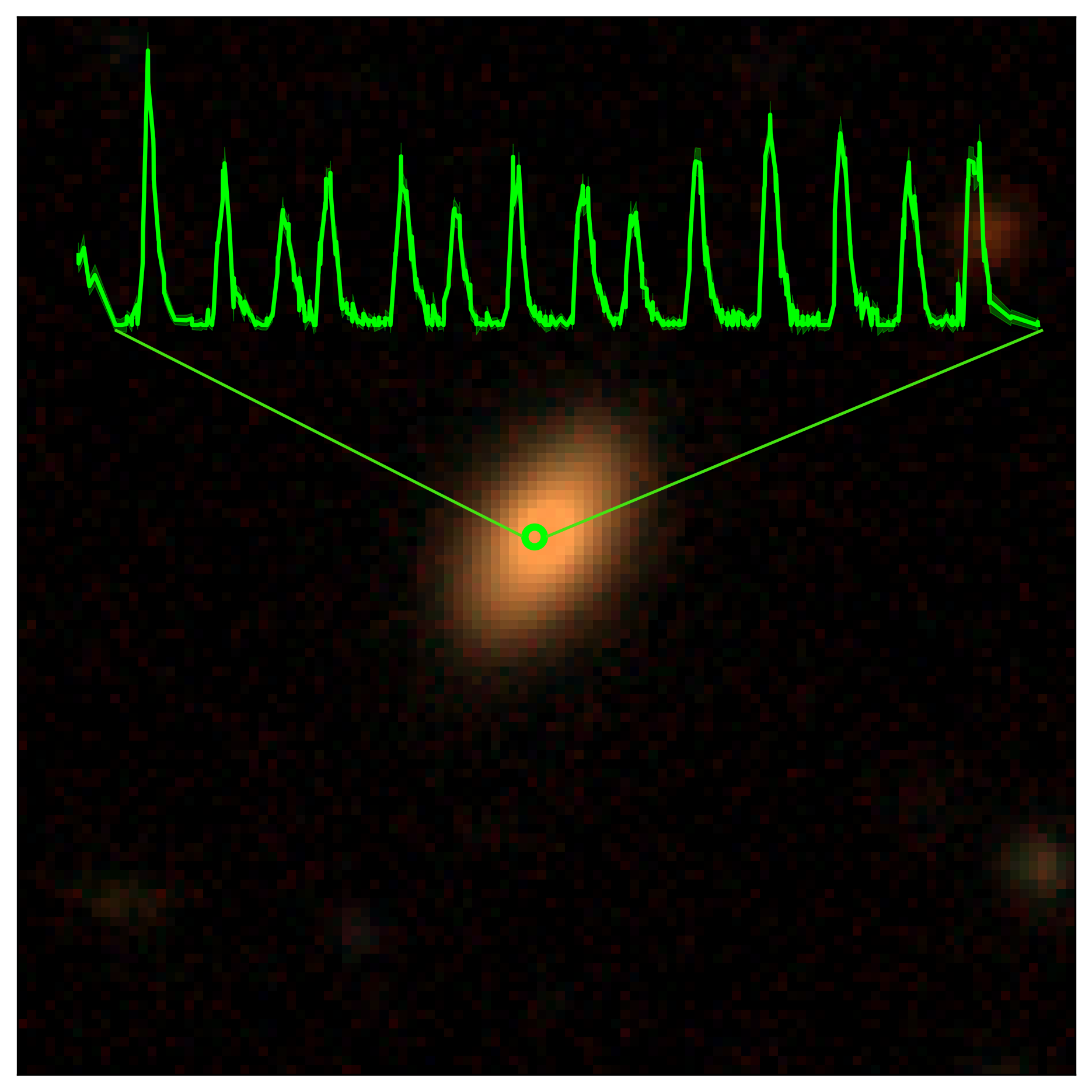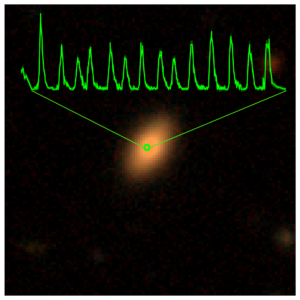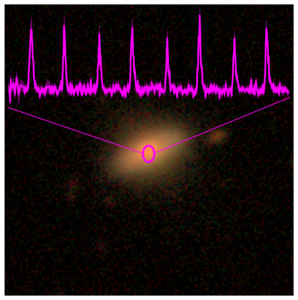
28 Apr eROSITA and SALT witness the awakening of massive black holes
Combined observations by eROSITA, the main instrument aboard the Spectrum-Röntgen-Gamma (SRG) satellite, and the Southern African Large Telescope (SALT) have led to an important discovery. Two apparently normal galaxies observed by eROSITA during its all-sky survey show quasi-periodic X-ray eruptions, despite them appearing to be dormant and inactive. The nuclei of these galaxies light up in X-rays every few hours, reach a peak brightness comparable to that of the entire galaxy. This pulsating behaviour might be due to a stellar object orbiting the central black hole, possibly quite massive. As these galaxies are relatively close and small, this discovery could help scientists to better understand how black holes are activated in low-mass galaxies.

Optical image of the first galaxy found with quasi-periodic eruptions in the eROSITA all-sky data, the NICER X-ray light-curve is overlayed in green. The galaxy was identified as 2MASS 02314715-1020112 at a redshift of z~0.05, determined by SALT. The peak-to-peak separation of the X-ray outbursts is about 18.5 hours. Credit: MPE; optical image: DESI Legacy Imaging Surveys/D. Lang (Perimeter Institute)
Quasars or “active galactic nuclei” (AGN) are often called the lighthouses of the distant universe. The brightness of their central region, where a very massive black hole accretes large amounts of material, can be thousands of times higher than that of a galaxy like our Milky Way.
“In the eROSITA all-sky survey, we have now found two previously dormant galaxies with huge, almost periodic sharp pulses in their X-ray emission,” says Riccardo Arcodia, PhD student at the Max Planck Institute for Extraterrestrial Physics (MPE), who is the first author of the study now published in Nature. These kinds of objects are fairly new: only two such sources were known before, found either serendipitously or in archival data in the past couple of years. “As this new type of erupting sources seems to be peculiar in X-rays, we decided to use eROSITA as a blind survey and immediately found two more,” he adds.

Optical image of the second galaxy found with quasi-periodic eruptions in the eROSITA all-sky data, the XMM-Newton X-ray light-curve is overlayed in magenta. The galaxy was identified as 2MASX J02344872-4419325 at a redshift of z~0.02, determined by SALT. This source shows much narrower and more frequent eruptions with a mean peak-to-peak separation of only about 2.4 hours. Credit: MPE; optical image: DESI Legacy Imaging Surveys/D. Lang (Perimeter Institute)
The eROSITA telescope currently scans the entire sky in X-rays and the continuous data stream is well suited to look for transient events, such as these eruptions. Both the new sources discovered by eROSITA showed high-amplitude X-ray variability within just a few hours, which was confirmed by follow-up observations with the XMM-Newton and NICER X-ray telescopes. Contrary to the two previously known similar objects, the host galaxies of these new sources found by eROSITA show no signs of previous black hole activity.
“These were normal, average low-mass galaxies with inactive black holes,” explains Andrea Merloni at MPE, principal investigator of eROSITA. “Without these sudden, repeating X-ray eruptions we would have ignored them.” The optical observations of the two galaxies concerned were obtained with SALT through a collaboration between the German eROSITA Consortium and SALT transient follow-up teams. “This is an exciting new result”, says David Buckley of the South African Astronomical Observatory, principal investigator of the SALT transient programme. “It shows that energetic X-ray emission from black hole interactions is not just confined to the nuclei of active galaxies. ”
Scientists now have the chance to explore the vicinity of supermassive black holes with relatively low masses of 100 000 to 10 million times the mass of our Sun.
Quasi-periodic emission, such as the one discovered by eROSITA, is typically associated with binary systems. If these eruptions are indeed triggered by the presence of an orbiting object, its mass has to be much smaller than the black hole’s – maybe of the order of a star or even a white dwarf, which might be partially disrupted by the huge tidal forces close to the black hole at each passage.
“We still do not know what causes these X-ray eruptions,” admits Arcodia. “But we know that the black hole’s neighbourhood was quiet until recently, so a pre-existing accretion disk, as present in active galaxies, is not required to trigger these phenomena.” Future X-ray observations will help to constrain or rule out the “orbiting object scenario” and to monitor possible changes in the orbital period. This scenario could also make these kinds of objects observable via both electromagnetic and gravitational wave signals, thus opening up new possibilities with multi-messenger astrophysics.
“This is the first major result from the SALT-eROSITA collaboration”, says Buckley. “Due to the unprecedented sensitivity of eROSITA, coupled with its repeated scanning of the entire sky, we are continuing to make new discoveries. These help to reveal the nature of variable X-ray sources in our Universe”.
Original publication
X-ray Quasi-Periodic Eruptions from two previously quiescent galaxies
- Arcodia, A. Merloni, K. Nandra, et al.
Nature, published 29 April 2021
Link / DOI: https://dx.doi.org/10.1038/s41586-021-03394-6
Contacts
Riccardo Arcodia, Max Planck Institute for Extraterrestrial Physics (MPE): arcodia@mpe.mpg.de
David Buckley, SAAO, dibnob@saao.ac.za
Daniel Cunnama, SAAO, daniel@saao.ac.za
